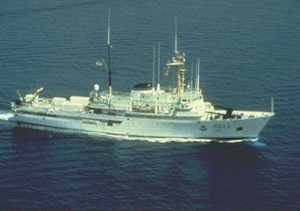NOAAS Researcher

| |
| History | |
|---|---|
| Name | USC&GS Researcher (OSS 03) |
| Namesake | A researcher, a person who engages in diligent inquiry or examination to seek or revise facts, principles, theories, etc. |
| Builder | American Shipbuilding Company, Toledo, Ohio |
| Launched | 1968 |
| Commissioned | 1970 |
| Fate | Transferred to National Oceanic and Atmospheric Administration 3 October 1970 |
| Name | NOAAS Researcher (R 103) |
| Namesake | Previous name retained |
| Acquired | Transferred from U.S. Coast and Geodetic Survey 3 October 1970 |
| Renamed | NOAAS Malcolm Baldrige (R 103) 1987 |
| Namesake | Malcolm Baldrige, Jr., (1922-1987), U.S. Secretary of Commerce 1981-1987 |
| Decommissioned | 23 August 1996 |
| Identification | IMO number: 6901907 |
| Status | Inactive, in reserve |
| General characteristics | |
| Type | Oceanographic research ship |
| Length | 278.3 ft (84.8 m) |
| Beam | 51 ft (16 m) |
| Draft | 18.3 ft (5.6 m) |

NOAAS Researcher (R 103), was an American oceanographic research vessel in commission in the National Oceanic and Atmospheric Administration (NOAA) from 1970 to 1996. Previously, she had been in commission in the United States Coast and Geodetic Survey in 1970 as USC&GS Researcher (OSS 03).
In 1987, Researcher was renamed NOAAS Malcolm Baldrige (R 103).
Construction and commissioning
Researcher was built in 1968 as an "ocean survey ship" (OSS) for the U.S. Coast and Geodetic Survey by the American Shipbuilding Company at Toledo, Ohio.[1] The Coast and Geodetic Survey commissioned her in 1970 as USC&GS Researcher (OSS 03). When the Coast and Geodetic Survey and other United States Government agencies merged to form NOAA on 3 October 1970, Researcher became a part of the NOAA fleet as NOAAS Researcher (R 103).
Operational career
Researcher operated as an all-purpose oceanographic research ship in all the world's oceans, conducting oceanographic and atmospheric research.[2]
In 1987, the long-serving United States Secretary of Commerce, Malcolm Baldrige, Jr., died in office of injuries suffered in a rodeo accident. In his honor, Researcher was renamed NOAAS Malcolm Baldrige (R 103) that year.[2] She was the first ship to be outfitted with an upgraded oceanographic system, the Scientific Computer System (SCS), which consisted of two MicroVAX computer systems that were networked to provide for both data acquisition and data processing functions. One of the MicroVAX systems was dedicated to acquiring, logging, and displaying data in real time and performing real-time data quality assurance functions, while the second MicroVAX was allocated to scientists embarked on the ship for data analysis and direction of their research.[1]
Malcolm Baldrige was the second NOAA ship to circumnavigate the Earth, leaving Miami, Florida, in February 1995, proceeding through the South Atlantic Ocean, Indian Ocean, and Pacific Ocean, and then through the Panama Canal to Norfolk, Virginia, where the voyage ended in early 1996.[2]
NOAA decommissioned Malcolm Baldrige on 23 August 1996.[1]
Sometime in the late 1990s, Malcolm Baldrige was sold to an Argentinian firm which operates the ship as the M/V Ushuaia, running tours to Antarctica.[citation needed]
